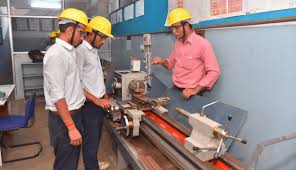
ITI IN FITTER
FIRST YEAR SYLLABUS
1. Professional Skill (Trade Practical)
(Focus: Basic Fitting Operations and Introduction to Machines)
- Workshop Safety & Discipline
- Importance of safety, first aid, fire prevention.
- Use of PPE (gloves, goggles, shoes, apron).
- Housekeeping and 5S concept.
- Introduction to Tools & Equipment
- Identification of hand tools: hammers, chisels, files, hacksaws, punches.
- Marking tools: scriber, divider, surface plate, V-block.
- Measuring tools: steel rule, calipers, vernier caliper, micrometer.
- Basic Fitting Operations
- Sawing, filing, drilling, tapping, reaming, counter-sinking, counter-boring.
- Preparation of male & female fitting jobs.
- Flatness and squareness checking using try square.
- Bench Work & Assembly
- Assembly of simple components using nuts, bolts, keys, pins.
- Practice on marking, fitting, alignment.
- Machine Introduction
- Familiarization with lathe, drilling, grinding, shaping machines.
- Safety precautions while working on machines.
- Sheet Metal and Pipe Work
- Cutting, bending and forming simple sheet-metal jobs.
- Pipe threading, bending and fitting with elbows, tees, unions.
- Maintenance & Lubrication
- Cleaning and lubrication of tools and machines.
- Simple maintenance schedules.
2. Professional Knowledge (Trade Theory)
- Introduction to Fitter Trade
- Role and scope of a fitter in industry.
- Types of industries using fitter skills.
- Engineering Materials
- Ferrous and non-ferrous metals, alloys, properties and uses.
- Heat treatment: annealing, hardening, tempering.
- Fitting Tools & Operations
- Types, classification, and use of hand tools.
- Measuring instruments and care of tools.
- Fasteners & Threads
- Different types of screws, bolts, nuts, studs.
- Types of threads and their applications (metric, BSW, NPT).
- Machine Tools (Introduction)
- Basic parts and operations of lathe, drilling and grinding machines.
- Basic Workshop Practice
- Bench work, marking, fitting, assembly.
- Safety & Maintenance
- Electrical safety, fire safety, preventive maintenance, use of first aid.
3. Workshop Calculation & Science
- Units, measurements, systems of units, conversion.
- Basic arithmetic (addition, subtraction, multiplication, division).
- Ratio, proportion, percentage, average.
- Area and perimeter of simple shapes.
- Volume and weight calculations.
- Basic trigonometry for angular measurements.
- Basic science: metals, heat and temperature, expansion of solids.
4. Engineering Drawing
- Drawing instruments and their use.
- Types of lines and their applications.
- Simple geometrical constructions.
- Orthographic and isometric projections.
- Sectional views of simple solids.
- Dimensioning methods and standards.
- Freehand sketching of simple tools and parts.
5. Employability Skills
- Communication skills (verbal & written).
- Teamwork, discipline, and punctuality.
- Computer basics and Internet awareness.
- Time management, self-motivation.
- Entrepreneurship basics: what is business, how to start small services.
- Occupational safety, health and environment (OSHE).
SECOND YEAR SYLLABUS
1. Professional Skill (Trade Practical)
(Focus: Advanced Fitting, Precision Work, Machine Maintenance)
- Precision Fitting
- Use of vernier height gauge, depth gauge, dial indicator.
- Fitting within limits and tolerances.
- Scraping, lapping, honing, polishing.
- Lathe Operations
- Facing, turning, step turning, taper turning.
- Thread cutting (internal/external).
- Drilling, boring, parting-off, knurling.
- Grinding & Finishing
- Surface and cylindrical grinding operations.
- Dressing and balancing grinding wheels.
- Welding & Fabrication
- Basic arc and gas welding (flat and lap joints).
- Brazing and soldering exercises.
- Machine Maintenance
- Dismantling and re-assembling of pumps, gearboxes, valves, couplings.
- Checking alignment using dial gauge.
- Lubrication system maintenance.
- Hydraulics & Pneumatics
- Identification of hydraulic/pneumatic components.
- Study of basic circuits.
- Preventive maintenance of hydraulic systems.
- Project Work
- Fabrication of mechanical assembly or fixture.
- Complete machine overhaul or repair job.
- In-plant training or job simulation.
2. Professional Knowledge (Trade Theory)
- Fits, Limits & Tolerances
- Classification and system of fits.
- Limit gauges, slip gauges, tolerance types.
- Machine Components & Assemblies
- Couplings, bearings, pulleys, keys, splines, clutches.
- Alignment methods.
- Maintenance Practices
- Breakdown vs preventive maintenance.
- Fault finding and troubleshooting.
- Hydraulic & Pneumatic Systems
- Basic principles, components, working and applications.
- Quality Control
- Inspection methods, use of gauges, comparators, and micrometers.
- Surface finish and roughness measurement.
- Modern Trends
- CNC, robotics, Industry 4.0 (basic awareness).
- Safety standards, environmental management, and energy conservation.
- Entrepreneurship & Industrial Practices
- Cost estimation, job pricing, managing workshop resources.
- Professional ethics and customer interaction.
3. Workshop Calculation & Science
- Advanced geometry: circles, triangles, polygons.
- Volume and surface area of cylinders, cones, and spheres.
- Calculation of cutting speed, feed and machining time.
- Power, work, and energy calculations.
- Tolerance and allowance calculations.
- Friction, pressure, and mechanical advantage.
- Stress, strain, and modulus of elasticity.
- Heat treatment and expansion.
4. Engineering Drawing
- Assembly and detailed drawings of machine parts.
- Sectional drawings (half/full section).
- Shaft, coupling, bearing, and gear assembly drawings.
- Thread profiles and conventions.
- Surface finish and welding symbols.
- Introduction to CAD (2D mechanical drafting).
5. Employability Skills
- Communication at workplace; customer handling.
- Resume writing and interview preparation.
- Entrepreneurship and self-employment guidance.
- Work ethics and teamwork.
- Digital literacy and online documentation.
- Productivity improvement and sustainability in workshop.

